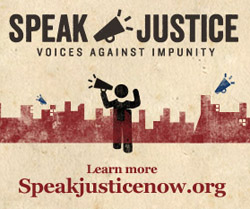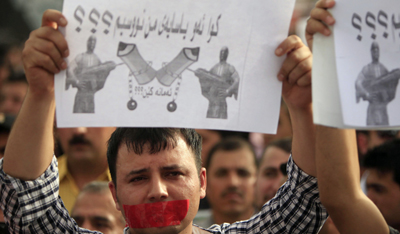
Speak Justice campaign fights impunity in press murders
The tortured and decapitated body of 39-year-old María Elizabeth Macías Castro was found on a Saturday evening in September 2011. It had been dumped by the side of a road in Nuevo Laredo, a Mexican border town ravaged by the war on drugs. Macías, a freelance journalist, wrote about organized crime on social media under…
Iraqi cybercrime bill is the worst kind
After the rash of political revolutions and criminal attacks on governments and companies last year, it wasn’t hard to predict that 2012 would be the year of a cybercrime crackdown. The United States is considering its own cybercrime legislation, and the European Union is seeking to harmonize its member state’s computer crime laws. Governments understandably…
Video: ‘Living in silence: Journalists in exile’
We write a lot at CPJ about the terrible things that happen to journalists because of their reporting, but we don’t often get a chance to show you what happens to them after they are forced to flee their homes and land abroad. This video, about three such journalists, is worth watching.

Anti-press violence in Iraqi Kurdistan, past and present
Kurdistan is different, as nearly every Iraqi Kurd I have ever met has said. Far less violent than the rest of Iraq since the U.S.-led invasion in 2003, the parts of the north controlled by the Kurdish Regional Government have escaped the kind of sectarian unrest that continues to flare in the south. But in…
Six stories: Online journalists killed in 2010
This week, CPJ published its year-end analysis of work-related fatalities among journalists. Six of the 42 victims worked online. While you can read the full statistics and our special report elsewhere, I want to highlight the stories of these six journalists who worked on the Web.
Murder, ‘suicide,’ crossfire: A week of journalist killings
Today we will report another murder of a journalist. This one was in Argentina. The last one we documented was a couple days ago–Alberto Graves Chakussanga was shot in the back in Angola. These tragedies are part of our daily work at CPJ, but this week was different. There have been eight killings of journalists…

Balancing risk vs. safety in global news reporting
CPJ’s Joel Simon will be live on Wednesday on “The Kojo Nnamdi Show,” a daily news public radio show in Washington. Joining Simon will be Iraqi journalist Haider Hamza, who has covered the war in Iraq for Reuters and ABC News, and Alfredo Corchado, the Mexico bureau chief for The Dallas Morning News, in a…

Veteran journalists seek justice in Iraqi Kurdistan
Last week, a number of prominent journalists who cover Iraqi Kurdistan wrote an open letter to the president of the Kurdish Regional Government, Massoud Barzani, and the president of Iraq, Talal Talabani, calling on them to bring to an end a sharp rise in violations of press freedom. A journalist was abducted and murdered in the country as…

FOIA needs new muscle behind it, not just promises
These are busy days for Freedom of Information. On April 5, the watchdog Web site that knows no borders, WikiLeaks, posted a classified U.S. military video showing U.S. forces firing on Iraqi civilians, killing many, including two Reuters journalists, as well as wounding children. Two days later, the Pentagon posted a redacted U.S. military assessment of the same incident concluding that U.S. troops fired “in accordance…
